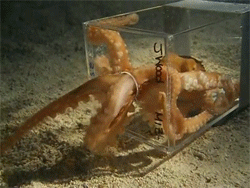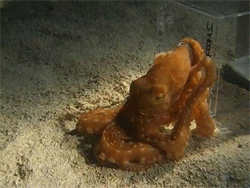My 2016 In Reading
My 2016 In Reading
THE BOOKS I LOVED SO MUCH I WANTED TO SEW THEM INTO MY SKIN AKA MY FAVORITE BOOKS OF THE YEAR IN NO PARTICULAR ORDER
Homegoing by Yaa Gyasi Another Brooklyn by Jacqueline Woodson Today I Am a Book by xTx The Three Woes by Casey Hannan A Bestiary by Lily Hoang Queen of the Night by Alexander Chee The Mothers by Brit Bennett Commonwealth by Ann Patchett
THE BOOK THAT OPENED MY EYES AND MIND AND BROKE MY HEART WITH THE PAINFUL REALITY TOO MANY AMERICANS LIVE WITH
Evicted by Matthew Desmond
THE BOOK THAT WAS TOTAL TRASH AND I THINK THE WRITER HATES FAT PEOPLE WHICH IS FINE BECAUSE WE ALL HAVE OUR ISSUES BUT STILL, GIRL, WHAT….
Maestra by L.S. Hilton
THE COMING OF AGE PROSE POETRY THAT MOVED ME IMMEASURABLY
The Pocket Knife Bible by Anis Mojgani
THE BOOK THAT MADE ME THINK HILLARY CLINTON REALLY WAS GOING TO WIN THE PRESIDENCY
All the Single Ladies by Rebecca Traister
THE STRANGE BOOK ABOUT LONELINESS AND THE THINGS WE DO ONLINE THAT I HIGHLY RECOMMEND
Valletta78 by Erin Fitzgerald
THE POETRY BOOK I DIDN’T UNDERSTAND AT ALL THOUGH I COULD TELL THE POEMS WERE SUPER SMART
The House of Lords and Commons by Ishion Hutchinson
THE ACTION THRILLER THAT HAD LOTS OF HYPE BLURBS BUT WAS ONLY SO SO
The Second Life of Nick Mason by Scott Hamilton
THE RETELLING OF A CLASSIC THAT I REALLY ENJOYED, WHICH SURPRISED ME AND ALSO THE AUTHOR WROTE ONE OF MY FAVORITE BOOKS OF ALL TIME, AMERICAN WIFE
Eligible by Curtis Sittenfeld
THE BOOK THAT MADE ME CRY BECAUSE IT HELD SO MUCH I COULD RELATE TO AND THEN MADE ME A LITTLE MAD
13 Ways of Looking at a Fat Girl by Mona Awad
EXCELLENT SMALL PRESS BOOKS YOU SHOULD CHECK OUT
Pink Museum by Caroline Crew The Farmacist by Ashley Farmer The Voyager Record by Anthony Michael Morena Massive Cleansing Fire by Dave Housley
THE BOOK I READ TO LEARN HOW TO WRITE A COMIC BOOK SERIES EVEN THOUGH I WAS WRITING FOR THEIR MAJOR COMPETITOR
The DC Comics Guide to Writing Comics by Dennis O’Neil
THE COMIC BOOK I LOVED AND RECOMMEND OFTEN
Saga by Brian Vaughan
THE COMIC BOOK ISSUE I READ AND THOUGHT WAS NOT SO GOOD SO I HAVEN’T READ ANY OTHER ISSUES IN THE SERIES
Wonder Woman Rebirth #1
THE BOOK I WROTE AN INTRODUCTION FOR (OUT IN 2017! FROM BEACON PRESS!)
Like One of the Family by Alice Childress
THE BOOK I REVIEWED FOR THE NEW YORK TIMES
Small Great Things by Jodi Picoult
THE BOOK I WANTED TO LOVE THAT HAD GORGEOUS OBSERVATIONS OF WOMEN’S FRIENDSHIPS
Rich and Pretty by Rumaan Alam
THE BOOK ABOUT CHEFS AND THEIR TATTOOS WITH FASCINATING STORIES OF WHY PEOPLE PERMANENTLY INK THEIR SKIN
Knives and Ink by Isaac Fitzgerald and Wendy MacNaughton
THE BOOK I READ BECAUSE I SAW A PREVIEW FOR THE TV SHOW AND LEARNED IT WAS BASED ON A BOOK SO I STARTED WONDERING IF THE BOOK WAS GOOD
Queen of the South by Arturo Perez-Reverte
SOME VERY GOOD BOOKS YOU SHOULD CHECK OUT BECAUSE THE STORIES ARE WARM AND/OR INTELLIGENT AND/OR STRANGE AND/OR GRIPPING AND/OR INTENSE
Turner House by Angela Flournoy LaRose by Louise Erdrich The Wangs vs the World by Jade Chang The Story of My Teeth by Valerie Luiselli You Will Know Me by Megan Abbott
THE HEARTBREAKING BOOK ABOUT BEING GAY IN THE MIDDLE EAST DURING THESE TUMULTUOUS TIMES FROM A WRITER WITH A LOT OF POTENTIAL
Guapa by Saleem Haddad
GORGEOUS BOOKS OF POETRY I REALLY LOVED
Night Sky With Exit Wounds by Ocean Vuong L’Heure Bleue by Elisa Gabbert The New Testament by Jericho Brown Look by Solmaz Sharif There Are More Beautiful Things Than Beyoncé by Morgan Parker
THE EXCELLENT BOOK I CHOSE AS MY SELECTION FOR BOOK OF THE MONTH CLUB
The Veins of the Ocean by Patricia Engel
THE BOOK I READ BASICALLY TO IMPRESS A GIRL AND IT WAS A PRETTY GOOD BOOK ALSO AND I HOPE THE GIRL WAS IMPRESSED BY MY DEDICATION BECAUSE THE BOOK WAS VERY LONG
The Fireman by Joe Hill
THE BOOK WITH AN AMAZING TITLE, SOME REALLY GOOD STORIES INCLUDING A RIFF ON ANTIQUES ROADSHOW AND ALSO SOME STORIES I LIKED LESS
American Housewife by Helen Ellis
THE BOOK THAT WAS EXCEPTIONALLY WRITTEN BUT I WANTED THE ACTUAL RAILROAD PART TO BE MORE FULLY REALIZED
The Underground Railroad by Colson Whitehead
FUN BOOKS THAT WERE FUN
The Assistants by Camille Perri China Rich Girlfriend by Kevin Kwan
THE BOOK ABOUT BEING SINGLE TOWARD THE MIDDLE OF YOUR LIFE THAT PRETTY MUCH EVERYONE IS GOING TO LOVE WHEN IT COMES OUT
All Grown Up by Jami Attenberg
THE EXCELLENT SHORT STORY COLLECTIONS COMING OUT AROUND THE SAME TIME AS DIFFICULT WOMEN THAT MADE ME JEALOUS AND ALSO SCARED OF THE COMPETITION
Homesick for Another World by Ottessa Moshfegh Always Happy Hour by Mary Miller
THE BOOK THAT WAS NOT MY CUP OF TEA BUT IT’S ME NOT THE BOOK
300 Arguments by Sarah Manguso
THE BOOKS I BLURBED (AND THEREFORE REALLY ENJOYED)
You’re the Most Beautiful Thing That Happened by Arisa White In the Not Quite Dark by Dana Johnson I Almost Forgot About You by Terry McMillan Feminist Baby by Loryn Brantz Lower Ed: The Troubling Rise of For-Profit Colleges in the New Economy by Tressie McMillan Cottom Bruja by Wendy C. Ortiz Sing For Your Life by Daniel Bergner Made for Love by Alissa Nutting
More Posts from Philosophical-amoeba and Others

(Image caption: This type of electrocorticography (ECoG) grid, which is implanted in patients about to undergo epilepsy surgery, enables researchers to record and transmit electrical signals to and from the surface of the brain. Credit: Mark Stone/University of Washington)
For the first time in humans, researchers use brain surface stimulation to provide ‘touch’ feedback to direct movement
In the quest to restore movement to people with spinal cord injuries, researchers have focused on getting brain signals to disconnected nerves and muscles that no longer receive messages that would spur them to move.
But grasping a cup or brushing hair or cooking a meal requires other feedback that has been lost in amputees and individuals with paralysis — a sense of touch. The brain needs information from a fingertip or limb or external device to understand how firmly a person is gripping or how much pressure is needed to perform everyday tasks.
Now, University of Washington researchers at the National Science Foundation Center for Sensorimotor Neural Engineering (CSNE) have used direct stimulation of the human brain surface to provide basic sensory feedback through artificial electrical signals, enabling a patient to control movement while performing a simple task: opening and closing his hand.
It’s a first step towards developing “closed loop,” bi-directional brain-computer interfaces (BBCIs) that enable two-way communication between parts of the nervous system. They would also allow the brain to directly control external prosthetics or other devices that can enhance movement — or even reanimate a paralyzed limb — while getting sensory feedback.
The results of this research will be published in the Oct.-Dec. 2016 issue of IEEE Transactions on Haptics. An early-access version of the paper is available online.
“We were able to provide a baseline degree of sensory feedback by direct cortical stimulation of the brain,” said lead author and UW bioengineering doctoral student Jeneva Cronin. “To our knowledge this is the first time it’s been done in a human patient who was awake and performing a motor task that depended on that feedback.”
The team of bioengineers, computer scientists and medical researchers from the CSNE and UW’s GRIDLab used electrical signals of different current intensities, dictated by the position of the patient’s hand measured by a glove he wore, to stimulate the patient’s brain that had been implanted with electrocorticographic (ECoG) electrodes. The patient then used those artificial signals delivered to the brain to “sense” how the researchers wanted him to move his hand.
“The question is: Can humans use novel electrical sensations that they’ve never felt before, perceive them at different levels and use this to do a task? And the answer seems to be yes,” said co-author and UW bioengineering doctoral student James Wu. “Whether this type of sensation can be as diverse as the textures and feelings that we can sense tactilely is an open question.”
They would also allow the brain to directly control external prosthetics or other devices that can enhance movement — or even reanimate a paralyzed limb — while getting sensory feedback.
It’s difficult for a person to mimic natural movements — whether using a prosthetic device or a limb that has become disconnected from the brain by neurological injury — without sensation. Though there are devices to assist patients with paralysis or who have undergone amputations with basic function, being able to feel again ranks highly on their priorities, researchers said.
Restoring this sensory feedback requires developing an “artificial” language of electrical signals that the brain can interpret as sensation and incorporate as useful feedback when performing a task.
The UW CSNE team frequently works with patients about to undergo epilepsy surgery who have recently had an ECoG electrode grid implanted on the surface of their brain. For several days or weeks, doctors constantly monitor their brain activity to pinpoint the origin of their seizures before operating.
By consenting to participate in research studies during this period when their brain is “wired,” these patients enable researchers to answer basic neurological questions. They can test which parts of the brain are activated during different behaviors, what happens when a certain region of the brain’s cortex is stimulated and even how to induce brain plasticity to promote rehabilitation and healing across damaged areas.
The potential to use ECoG electrodes implanted on the surface of the brain in future prosthetic or rehabilitative applications offers several advantages — the signals are stronger and more accurate than sensors placed on the scalp, but less invasive than ones that penetrate the brain, as in a recent study by University of Pittsburgh researchers.
In the UW study, three patients wore a glove embedded with sensors that provided data about where their fingers and joints were positioned. They were asked to stay within a target position somewhere between having their hands open and closed without being able to see what that target position was. The only feedback they received about the target hand position was artificial electrical data delivered by the research team.
When their hands opened too far, they received no electrical stimulus to the brain. When their hand was too closed – similar to squeezing something too hard – the electrical stimuli was provided at a higher intensity.
One patient was able to achieve accuracies in reaching the target position well above chance when receiving the electrical feedback. Performance dropped when the patient received random signals regardless of hand position, suggesting that the subject had been using the artificial sensory feedback to control hand movement.
Providing that artificial sensory feedback in a way that the brain can understand is key to developing prosthetics, implants or other neural devices that could restore a sense of position, touch or feeling in patients where that connection has been severed.
“Right now we’re using very primitive kinds of codes where we’re changing only frequency or intensity of the stimulation, but eventually it might be more like a symphony,” said co-author Rajesh Rao, CSNE director and UW professor of computer science & engineering.
“That’s what you’d need to do to have a very natural grip for tasks such as preparing a dish in the kitchen. When you want to pick up the salt shaker and all your ingredients, you need to exert just the right amount of pressure. Any day-to-day task like opening a cupboard or lifting a plate or breaking an egg requires this complex sensory feedback.”
Curves of constant width

Source
The width of a circle is constant: its diameter.
But the circle is not the only shape that holds this pristine title. For instance let’s look at the Reuleaux triangle
Reuleaux triangle
A Reuleaux triangle is a shape formed from the intersection of three circular disks, each having its center on the boundary of the other two.

The Reuleaux triangle is the first of a sequence of Reuleaux polygons, curves of constant width formed from regular polygons with an odd number of sides.
Some of these curves have been used as the shapes of coins

To drill square holes.

They are not entirely square, their edges are fillets i.e the edges are rounded and not sharp.
This animation offers a good insight as to why that is so.

And in china, apparently on bicycles.
The man Guan Baihua shows his self-made multi-angle-wheel bicycle on May 6, 2009 in Qingdao of Shandong Province, China. Guan Baihua spent 18 months to complete this strange bicycle.

Other shapes of constant width
There are other shapes of constant width beside the Reuleaux triangle ( that has been discussed in this post ), a whole bunch of them really. Do take a look at them. ( links below )
I will leave you guys with my favorite one.

More:
If this post fascinated you, i strongly suggest you check these out. They go in-depth with the mathematics that underlies these curves and talk about other cool stuff:
An animation of non-circular rollers
Shapes and Solids of Constant Width - Numberphile
Shapes of constant width
Reuleaux Polygons,
Edit:
For those who are wondering if these are something that one would stumble upon on a regular basis. You may not find perfect ones but similiar ones definitely.
I found mine on a really old BMI calculator thingy. ( not sure what you would call it )

Have fun exploring !
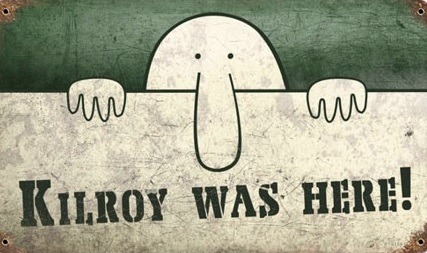
Kilroy Was Here!
He’s engraved in stone in the National World War II Memorial in Washington, DC – back in a small alcove where very few people have seen it. For the WWII generation, this will bring back memories. For younger folks, it’s a bit of trivia that is an intrinsic part of American history and legend.
Anyone born between 1913 to about 1950, is very familiar with Kilroy. No one knew why he was so well known….but everybody seemed to get into it. It was the fad of its time!

At the National World War II Memorial in Washington, DC
So who was Kilroy?
In 1946 the American Transit Association, through its radio program, “Speak to America,” sponsored a nationwide contest to find the real Kilroy….now a larger-than-life legend of just-ended World War II….offering a prize of a real trolley car to the person who could prove himself to be the genuine article.

Almost 40 men stepped forward to make that claim, but only James Kilroy from Halifax, Massachusetts, had credible and verifiable evidence of his identity.
“Kilroy” was a 46-year old shipyard worker during World War II (1941-1945) who worked as a quality assurance checker at the Fore River Shipyard in Quincy, Massachusetts (a major shipbuilder for the United States Navy for a century until the 1980s).
His job was to go around and check on the number of rivets completed. (Rivets held ships together before the advent of modern welding techniques.) Riveters were on piece work wages….so they got paid by the rivet. He would count a block of rivets and put a check mark in semi-waxed lumber chalk (similar to crayon), so the rivets wouldn’t be counted more than once.

A warship hull with rivets
When Kilroy went off duty, the riveters would surreptitiously erase the mark. Later, an off-shift inspector would come through and count the rivets a second time, resulting in double pay for the riveters!
One day Kilroy’s boss called him into his office. The foreman was upset about unusually high wages being “earned” by riveters, and asked him to investigate. It was then he realized what had been going on.
The tight spaces he had to crawl in to check the rivets didn’t lend themselves to lugging around a paint can and brush, so Kilroy decided to stick with the waxy chalk. He continued to put his check mark on each job he inspected, but added ”KILROY WAS HERE!“ in king-sized letters next to the check….and eventually added the sketch of the guy with the long nose peering over the fence….and that became part of the Kilroy message.

Kilroy’s original shipyard inspection “trademark” during World War II
Once he did that, the riveters stopped trying to wipe away his marks.
Ordinarily the rivets and chalk marks would have been covered up with paint. With World War II on in full swing, however, ships were leaving the Quincy Yard so fast that there wasn’t time to paint them. As a result, Kilroy’s inspection “trademark” was seen by thousands of servicemen who boarded the troopships the yard produced.
His message apparently rang a bell with the servicemen, because they picked it up and spread it all over the European and the Pacific war zones.

Before war’s end, “Kilroy” had been here, there, and everywhere on the long hauls to Berlin and Tokyo.
To the troops outbound in those ships, however, he was a complete mystery; all they knew for sure was that someone named Kilroy had “been there first.” As a joke, U.S. servicemen began placing the graffiti wherever they landed, claiming it was already there when they arrived.

As the World War II wore on, the legend grew. Underwater demolition teams routinely sneaked ashore on Japanese-held islands in the Pacific to map the terrain for coming invasions by U.S. troops (and thus, presumably, were the first GI’s there). On one occasion, however, they reported seeing enemy troops painting over the Kilroy logo!
Kilroy became the U.S. super-GI who had always “already been” wherever GIs went. It became a challenge to place the logo in the most unlikely places imaginable. (It is said to now be atop Mt. Everest, the Statue of Liberty, the underside of the Arc de Triomphe in Paris, and even scrawled in the dust on the moon by the American astronauts who walked there between 1969 and 1972.

In 1945, as World War II was ending, an outhouse was built for the exclusive use of Allied leaders Harry Truman, Joseph Stalin, and Winston Churchill at the Potsdam Conference. It’s first occupant was Stalin, who emerged and asked his aide (in Russian), “Who is Kilroy?”
To help prove his authenticity in 1946, James Kilroy brought along officials from the shipyard and some of the riveters. He won the trolley car….which he attached to the Kilroy home and used to provide living quarters for six of the family’s nine children….thereby solving what had become an acute housing crisis for the Kilroys.

The new addition to the Kilroy family home.
* * * *
And the tradition continues into the 21st century…

In 2011 outside the now-late-Osama Bin Laden’s hideaway house in Abbottabad, Pakistan….shortly after the al-Qaida-terrorist was killed by U.S. Navy SEALs.
>>Note: The Kilroy graffiti on the southwest wall of the Bin Laden compound pictured above was real (not digitally altered with Microsoft Paint, as postulated by some). The entire compound was leveled in 2012 for redevelopment by a Pakistani company as an amusement park….and to avoid it becoming a shrine to Bin Laden’s nefarious memory.
* * * *
A personal note….
My Dad’s trademark signature on cards, letters and notes to my sisters and I for the first 50 or so years of our lives (until we lost him to cancer) was to add the image of “Kilroy” at the end. We kids never ceased to get a thrill out of this….even as we evolved into adulthood.
To this day, the “Kilroy” image brings back a vivid image of my awesome Dad into my head….and my heart!
Dad: This one’s for you!

List of Free Science Books
Here’s an alphabetical list of all available free books. Note that many of the links will bring you to an external page, usually with more info about the book and the download links. Also, the links are updated as frequently as possible, however some of them might be broken. Broken links are constantly being fixed. In case you want to report a broken link, or a link that violates copyrights, use the contact form.
A
A Beginner’s Guide to Mathematica
A Brief Introduction to Particle Physics
A First Course in General Relativity
A New Astronomy
A No-Nonsense Introduction to General Relativity
A Popular History of Astronomy During the Nineteenth Century, Fourth Edition
A Review of General Chemistry
A Simple Guide to Backyard Astronomy
A Text Book for High School Students Studying Physics
A Tour of Triangle Geometry
About Life: Concepts in Modern Biology
Acoustic Emission
Adaptive Control
Advanced Calculus
Advanced Learning
Advanced Mathematics for Engineers
Advanced Microwave Circuits and Systems
Advanced Technologies
Advances in Computer Science and IT
Advances in Evolutionary Algorithms
Advances in Geoscience and Remote Sensing
Advances in Haptics
Advances in Human Computer Interaction
Age of Einstein
Aging by Design
AMPL: A Modeling Language for Mathematical Programming
An Introduction to Elementary Particles
An Introduction to Higher Mathematics
An Introduction to Many Worlds in Quantum Computation
An Introduction to Mathematical Reasoning
An Introduction to Mathematics
An Introduction to Proofs and the Mathematical Vernacular
An Introduction to Relativistic Quantum Mechanics
Analysis 1 (Tao T)
Analysis 2 (Tao T)
Analytic Functions
Astronomical Discovery
Astronomy for Amateurs
Astronomy Today
Astronomy with an Opera-Glass
Automation and Robotics
B
Basic Algebra, Topology and Differential Calculus
Basic Concepts of Mathematics
Basic Concepts of Thermodynamics
Basic Concepts of Thermodynamics Chapter 1
Basic Ideas in Chemistry
Basic Math: Quick Reference eBook
Basic Mathematics for Astronomy
Basic Physics
Basic Positional Astronomy
Basic Principles of Classical and Statistical Thermodynamics
Basic Principles of Physics
Basics of Physics
Beginner’s Botany
Biochemistry
Biochemistry (practice book)
Biology
Board Notes for Particle Physics
Book of Proof
C
Calculus
Calculus Based Physics
Celestial Navigation, Elementary Astronomy, Piloting
Circuit QED — Lecture Notes
Classical Dynamics
Classical Geometry
Classical Mechanics
Climate Models
Collaborative Statistics
College Algebra
Complex Analysis
Computational Geometry
Computational Introduction to Number Theory and Algebra
Computational Physics with Python
Conceptual Physics
Consistent Quantum Theory
Cook-Book Of Mathematics
College Physics
Crude Oil Emulsions- Composition Stability and Characterization
Curiosities of the Sky
D
Decoherence: Basic Concepts and Their Interpretation
Do We Really Understand Quantum Mechanics?
Differential Equations
Diophantine Analysis
Discover Physics
Dr. Donald Luttermoser’s Physics Notes
Dynamics and Relativity
E
Earthquake Research and Analysis
Earthquake-Resistant Structures – Design, Assessment and Rehabilitation
Einstein for Everyone
Electromagnetic Field Theory
Elementary Mathematical Astronomy
Elementary Linear Algebra
Elementary Particle Physics in a Nutshell
Elementary Particles in Physics
Elements of Astrophysics
Embedded Systems – Theory and Design Methodology
Encyclopaedia of Mathematics
Encyclopedia of Astrophysics
Engineering Mathematics 1
Engineering Mathematics with Tables
Essential Engineering Mathematics
Essential Physics
Exoplanet Observing for Amateurs
Experimental Particle Physics
F
Fields
Foundations of Nonstandard Analysis
Frequently Asked Questions about Calendars
Fundamental Concepts of Mathematics
Fundamentals of Analysis (Chen W.W.L)
Further Mathematical Methods
Fusion Physics
G
General Chemistry
General Relativity
General Relativity
Geometric Asymptotics
Geometry and Group Theory
Geometry and Topology
Geometry Formulas and Facts
Geometry Study Guide
Geometry, Topology and Physics
Geometry, Topology, Localization and Galois Symmetry
Great Astronomers
H
Handbook of Formulae and Physical Constants
High School Mathematics Extensions
Higher Mathematics for Engineers and Physicists
History of Astronomy
Homeomorphisms in Analysis
How to Use Experimental Data to Compute the Probability of Your Theory
I
Intelligent Systems
Intrinsic Geometry of Surfaces
Introduction to Astronomy and Cosmology
Introduction to Cancer Biology
Introduction to Chemistry
Introduction to Cosmology
Introduction to Elementary Particles
Introduction to General Relativity
Introduction To Finite Mathematics
Introduction to Particle Physics Notes
Introduction to PID Controllers
Introduction to Quantum Mechanics with Applications to Chemistry
Introduction to Quantum Noise, Measurement and Amplification
Introduction to Social Network Methods
Introduction to String Field Theory
Introduction to the Time Evolution of Open Quantum Systems
Introduction to Quantum Mechanics
Introductory Computational Physics
Introductory Physics 1
Introductory Physics 2
K
Kinetic Theory
L
Laboratory Manual for Introductory Physics
Laws of Physics
Learn Physics Today
Lecture Notes in Discrete Mathematics
Lecture Notes in Quantum Mechanics
Lecture Notes in Nuclear and Particle Physics
Lecture Notes in Particle Physics
Lecture Notes on General Relativity
Lectures on Astronomy, Astrophysics, and Cosmology
Lectures on Particle Physics
Lectures on Riemann Zeta-Function
Light and Matter
M
Mag 7 Star Atlas Project
Many Particle Physics
Math Alive
Mathematical Analysis I(Zakon E)
Mathematical Biology
Mathematical Methods
Mathematical Methods 1
Mathematical Methods for Physical Sciences
Mathematical Methods of Engineering Analysis
Mathematics, Basic Math and Algebra
Mathematics for Computer Science
Mathematics for Computer Science
Mathematics for Computer Scientists
Mathematics For Engineering Students
Mathematics Formulary
Motion Mountain
Music: A Mathematical Offering
Mysteries of the Sun
N
Natural Disasters
New Frontiers in Graph Theory
Noise Control, Reduction and Cancellation Solutions in Engineering
Nondestructive Testing Methods and New Applications
Nonlinear Optics
Notes on Coarse Geometry
Notes on Elementary Particle Physics
Notes on Quantum Mechanics
O
Observing the Sky from 30S
On Particle Physics
Operating Systems: Three Easy Pieces
P
Particle Physics Course Univ. Cape Town
Particle Physics Lecture Notes
People’s Physics Book
Perspectives in Quantum Physics: Epistemological, Ontological and Pedagogical
Photons, Schmotons
Physics Lectures
Physics Tutorials
Physics Study Guides
Pioneers of Science
Practical Astronomy
Practical Astronomy for Engineers
Preparing for College Physics
Primer Of Celestial Navigation
Principal Component Analysis – Multidisciplinary Applications
Publications of the Astronomical Society of the Pacific Volume 1
Q
Quantum Dissipative Systems
Quantum Field Theory
Quantum Fluctuations
Quantum Information Theory
Quantum Magnetism
Quantum Mechanics
Quantum Mechanics
Quantum Mechanics: A Graduate Course
Quantum Mechanics: An Intermediate Level Course
Quantum Notes
Quantum Physics Notes
Quantum Theory of Many-Particle Systems
Quantum Transients
R
Recreations in Astronomy
Relativistic Quantum Dynamics
Relativity: The Special and General Theory
Review of Basic Mathematics
Riemann Surfaces, Dynamics and Geometry Course Notes
S
Short History of Astronomy
Sintering of Ceramics – New Emerging Techniques
Solitons
Some Basic Principles from Astronomy
Special Relativity
Spherical Astronomy
Star-Gazer’s Hand-Book
Statistical Physics
Street-Fighting Mathematics
String Theory
Structures of Life
Supernova Remnants: The X-ray Perspective
Superspace: One Thousand and One Lessons in Supersymmetry
System of Systems
T
The Astrobiology Primer: An Outline of General Knowledge
The Astronomy and the Bible
The Astronomy of the Bible: An Elementary Commentary on the Astronomical References of Holy Scripture
The Basic Paradoxes of Statistical Classical Physics and Quantum Mechanics
The Beginning and the End
The Beginning and the End of the Universe
The Complete Idiot’s Guide to the Sun
The Convenient Setting of Global Analysis
The Eightfold Way: The Beauty of Klein’s Quartic Curve
The General Theory of Relativity
The Geology of Terrestrial Planets
The Geometry of the Sphere
The Handbook of Essential Mathematics
The Moon: A Full Description and Map of its Principal Physical Features
The Open Agenda
The Origin of Mass in Particle Physics
The Particle Detector Brief Book
The Physics Hypertextbook
The Physics of Quantum Mechanics
The Planet Mars
The Small n Problem in High Energy Physics
The Story of Eclipses
The Story of the Heavens
The Structure of Life
The Wonder Book of Knowledge
The World According to the Hubble Space Telescope
The Zij as-Sanjari of Gregory Chioniades (June 27, 2009)
Three Dimensional Geometry
U
Understanding Physics
Unfolding the Labyrinth
Utility of Quaternions in Physics
Uses of Astronomy





The Screwtape Letters C S Lewis London Geoffrey Bles - The Centenary Press 1942 - First Published February 1942, Reprinted March 1942, Reprinted March 1942
dedicated to J R R Tolkien
The Okinawan Language
Anybody who has studied Japanese and Linguistics will know that Japanese is a part of the Japonic language family. For many years it was thought that Japanese was a language isolate, unrelated to any other language (Although there is some debate as to whether or not Japanese and Korean are related). Today, most linguists are in agreement that Japanese is not an isolate. The Japonic languages are split into two groups: Japanese (日本語) and its dialects, which range from standard Eastern Japanese (東日本方言) to the various dialects found on Kyūshū (九州日本方言), which are, different, to say the least. The Ryukyuan Languages (琉球語派). Which are further subdivided into Northern and Southern Ryukyuan languages. Okinawan is classified as a Northern Ryukyuan Languages. There are a total of 6 Ryukyuan languages, each with its own dialects. The Ryukyuan languages exist on a continuum, somebody who speaks Okinawan will have a more difficult time understanding the Yonaguni Language, which is spoken on Japan’s southernmost populated island. Japanese and Okinawan (I am using the Naha dialect of Okinawan because it was the standard language of the Ryukyu Kingdom), are not intelligible. Calling Okinawan a dialect of Japanese is akin to calling Dutch a dialect of English. It is demonstrably false. Furthermore, there is an actual Okinawan dialect of Japanese, which borrows elements from the Okinawan language and infuses it with Japanese. So, where did the Ryukyuan languages come from? This is a question that goes hand in hand with theories about where Ryukyuan people come from. George Kerr, author of Okinawan: The History of an Island People (An old book, but necessary read if you’re interested in Okinawa), theorised that Ryukyuans and Japanese split from the same population, with one group going east to Japan from Korea, whilst the other traveled south to the Ryukyu Islands. “In the language of the Okinawan country people today the north is referred to as nishi, which Iha Fuyu (An Okinawn scholar) derives from inishi (’the past’ or ‘behind’), whereas the Japanese speak of the west as nishi. Iha suggests that in both instances there is preserved an immemorial sense of the direction from which migration took place into the sea islands.” (For those curious, the Okinawan word for ‘west’ is いり [iri]). But, it must be stated that there are multiple theories as to where Ryukyuan and Japanese people came from, some say South-East Asia, some say North Asia, via Korea, some say that it is a mixture of the two. However, this post is solely about language, and whilst the relation between nishi in both languages is intriguing, it is hardly conclusive. With that said, the notion that Proto-Japonic was spoken by migrants from southern Korea is somewhat supported by a number of toponyms that may be of Gaya origin (Or of earlier, unattested origins). However, it also must be said, that such links were used to justify Japanese imperialism in Korea. Yeah, when it comes to Japan and Korea, and their origins, it’s a minefield. What we do know is that a Proto-Japonic language was spoken around Kyūshū, and that it gradually spread throughout Japan and the Ryukyu Islands. The question of when this happened is debatable. Some scholars say between the 2nd and 6th century, others say between the 8th and 9th centuries. The crucial issue here, is the period in which proto-Ryukyuan separated from mainland Japanese. “The crucial issue here is that the period during which the proto-Ryukyuan separated(in terms of historical linguistics) from other Japonic languages do not necessarily coincide with the period during which the proto-Ryukyuan speakers actually settled on the Ryūkyū Islands.That is, it is possible that the proto-Ryukyuan was spoken on south Kyūshū for some time and the proto-Ryukyuan speakers then moved southward to arrive eventually in the Ryūkyū Islands.” This is a theory supported by Iha Fuyu who claimed that the first settlers on Amami were fishermen from Kyūshū. This opens up two possibilities, the first is that ‘Proto-Ryukyuan’ split from ‘Proto-Japonic’, the other is that it split from ‘Old-Japanese’. As we’ll see further, Okinawan actually shares many features with Old Japanese, although these features may have existed before Old-Japanese was spoken. So, what does Okinawan look like? Well, to speakers of Japanese it is recognisable in a few ways. The sentence structure is essentially the same, with a focus on particles, pitch accent, and a subject-object-verb word order. Like Old Japanese, there is a distinction between the terminal form ( 終止形 ) and the attributive form ( 連体形 ). Okinawan also maintains the nominative function of nu ぬ (Japanese: no の). It also retains the sounds ‘wi’ ‘we’ and ‘wo’, which don’t exist in Japanese anymore. Other sounds that don’t exist in Japanese include ‘fa’ ‘fe’ ‘fi’ ‘tu’ and ‘ti’. Some very basic words include: はいさい (Hello, still used in Okinawan Japanese) にふぇーでーびる (Thank you) うちなー (Okinawa) 沖縄口 (Uchinaa-guchi is the word for Okinawan) めんそーれー (Welcome) やまとぅ (Japan, a cognate of やまと, the poetic name for ‘Japan’) Lots of Okinawan can be translated into Japanese word for word. For example, a simple sentence, “Let’s go by bus” バスで行こう (I know, I’m being a little informal haha!) バスっし行ちゃびら (Basu sshi ichabira). As you can see, both sentences are structured the same way. Both have the same loanword for ‘bus’, and both have a particle used to indicate the means by which something is achieved, ‘で’ in Japanese, is ‘っし’ in Okinawan. Another example sentence, “My Japanese isn’t as good as his” 彼より日本語が上手ではない (Kare yori nihon-go ga jouzu dewanai). 彼やか大和口ぬ上手やあらん (Ari yaka yamatu-guchi nu jooji yaaran). Again, they are structured the same way (One important thing to remember about Okinawan romanisation is that long vowels are represented with ‘oo’ ‘aa’ etc. ‘oo’ is pronounced the same as ‘ou’). Of course, this doesn’t work all of the time, if you want to say, “I wrote the letter in Okinawan” 沖縄語で手紙を書いた (Okinawa-go de tegami wo kaita). 沖縄口さーに手紙書ちゃん (Uchinaa-guchi saani tigami kachan). For one, さーに is an alternate version of っし, but, that isn’t the only thing. Okinawan doesn’t have a direct object particle (を in Japanese). In older literary works it was ゆ, but it no longer used in casual speech. Introducing yourself in Okinawan is interesting for a few reasons as well. Let’s say you were introducing yourself to a group. In Japanese you’d say みんなさこんにちは私はフィリクスです (Minna-san konnichiwa watashi ha Felixdesu) ぐすよー我んねーフィリクスでぃいちょいびーん (Gusuyoo wan’nee Felix di ichoibiin). Okinawan has a single word for saying ‘hello’ to a group. It also showcases the topic marker for names and other proper nouns. In Japanese there is only 1, は but Okinawan has 5! や, あー, えー, おー, のー! So, how do you know which to use? Well, there is a rule, typically the particle fuses with short vowels, a → aa, i → ee, u → oo, e → ee, o → oo, n → noo. Of course, the Okinawan pronoun 我ん, is a terrible example, because it is irregular, becoming 我んねー instead of 我んのー or 我んや. Yes. Like Japanese, there are numerous irregularities to pull your hair out over! I hope that this has been interesting for those who have bothered to go through the entire thing. It is important to discuss these languages because most Ryukyuan languages are either ‘definitely’ or ‘critically’ endangered. Mostly due to Japanese assimilation policies from the Meiji period onward, and World War 2. The people of Okinawa are a separate ethnic group, with their own culture, history, poems, songs, dances and languages. It would be a shame to lose something that helps to define a group of people like language does. I may or may not look in the Kyūshū dialects of Japanese next time. I’unno, I just find them interesting.
12 Amazing Facts About Elephants
In honor of World Elephant Day, we present you with 12 little known facts about one of our favorite creatures…in GIFs, of course.
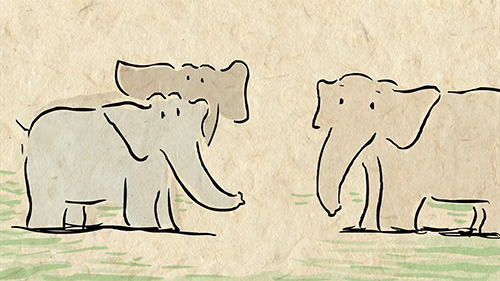
1. Elephants know every member of their herd and are able to recognize up to 30 companions by sight or smell.
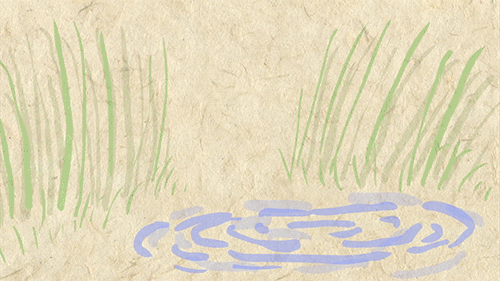
2. They can remember and distinguish particular cues that signal danger and can recall locations long after their last visit.

3. An elephant’s memory is not limited to its herd, nor is it limited to its species. In one instance, two circus elephants that performed together rejoiced when crossing paths 23 years later. Elephants have also recognized humans that they once bonded with after decades apart. 4.
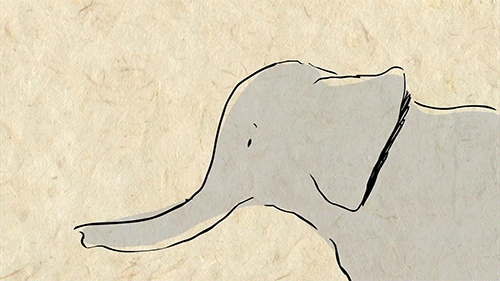
4. The elephant boasts the largest brain of any land mammal as well as an impressive encephalization quotient (the size of the animal’s brain relative to its body size). The elephant’s EQ is nearly as high as a chimpanzee’s.
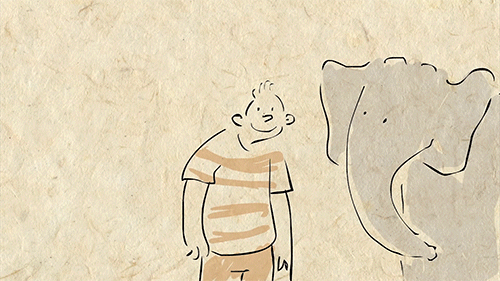
5. The elephant brain is remarkably similar to the human brain, with as many neurons and synapses, as well as a highly developed hippocampus and cerebral cortex.

6. Elephants are one of the few non-human animals to suffer from post-traumatic stress disorder.

7. Elephants are creative problem solvers.

8. Don’t try to outsmart an elephant! They have an understanding of basic arithmetic and can even keep track of relative quantities.

9. Elephants communicate using everything from body signals to infrared rumbles that can be heard from kilometers away. Their understanding of syntax suggests that they have their own language and grammar.
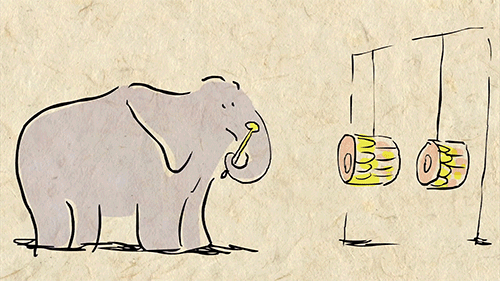
10. Elephants can recognize 12 distinct tones of music and recreate melodies.

11. Elephants are the only non-human animals to mourn their dead, performing burial rituals and returning to visit graves.
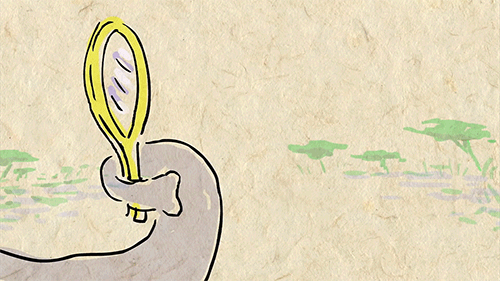
12. Elephants are one of the few species who can recognize themselves in the mirror.
Given what we now know about elephants, and what they continue to teach us about animal intelligence, it is more important than ever to make sure that these magnificent creatures do not vanish.
Check out some more fun elephant facts here and be sure to watch the TED-Ed Lesson Why elephants never forget - Alex Gendler
Animation by the ever-talented Avi Ofer
-
 moodymeangirl reblogged this · 7 months ago
moodymeangirl reblogged this · 7 months ago -
 moodymeangirl liked this · 7 months ago
moodymeangirl liked this · 7 months ago -
 littlegreenrainboots reblogged this · 7 months ago
littlegreenrainboots reblogged this · 7 months ago -
 silkworm88 liked this · 7 months ago
silkworm88 liked this · 7 months ago -
 sen-jou liked this · 1 year ago
sen-jou liked this · 1 year ago -
 predmeskaunur liked this · 1 year ago
predmeskaunur liked this · 1 year ago -
 chiakihoung liked this · 1 year ago
chiakihoung liked this · 1 year ago -
 chairytale liked this · 2 years ago
chairytale liked this · 2 years ago -
 impsblmchns liked this · 4 years ago
impsblmchns liked this · 4 years ago -
 littleredqueen128-blog liked this · 4 years ago
littleredqueen128-blog liked this · 4 years ago -
 brutalistsluts liked this · 4 years ago
brutalistsluts liked this · 4 years ago -
 naava79 liked this · 4 years ago
naava79 liked this · 4 years ago -
 browniepokemon reblogged this · 4 years ago
browniepokemon reblogged this · 4 years ago -
 narfingpotato reblogged this · 4 years ago
narfingpotato reblogged this · 4 years ago -
 browniepokemon liked this · 4 years ago
browniepokemon liked this · 4 years ago -
 rosulas liked this · 4 years ago
rosulas liked this · 4 years ago -
 blueleys liked this · 4 years ago
blueleys liked this · 4 years ago -
 andromedahonks liked this · 5 years ago
andromedahonks liked this · 5 years ago -
 mangos-bitch liked this · 5 years ago
mangos-bitch liked this · 5 years ago -
 satansparkedcar liked this · 5 years ago
satansparkedcar liked this · 5 years ago -
 zitrolena liked this · 5 years ago
zitrolena liked this · 5 years ago
A reblog of nerdy and quirky stuff that pique my interest.
291 posts

